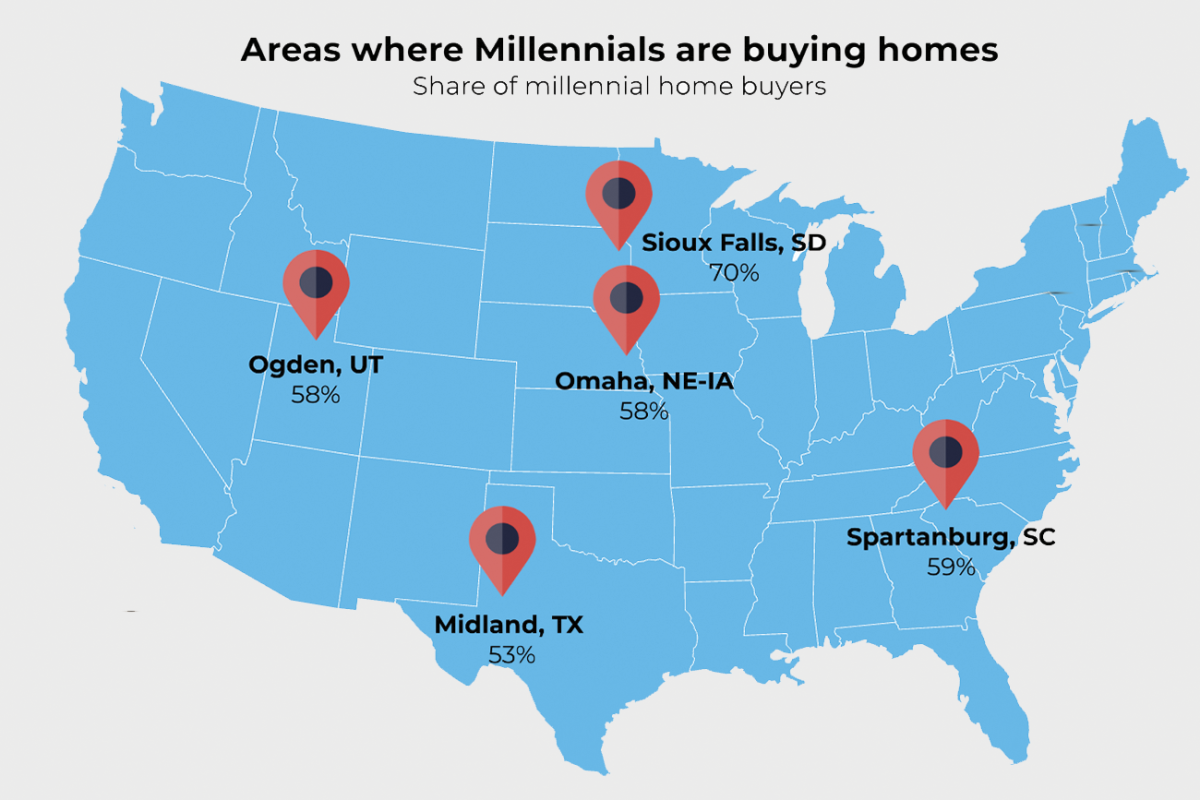According to the NAR Home Buyer and Seller Generational Trends Report, millennial buyers (22 to 40 years old) continue to make up the largest share of home buyers at 37%. In fact, millennials have been the largest share of buyers since 2014. The National Association of REALTORS® analyzed data from the 2019 American Community Survey to identify areas with high shares of millennial home buyers. See below for the characteristics of these home buyers, their preferences and what it means for the local economy.
In the following areas, millennials made up more than 50% of the home buyers—these are some of the areas with a high share of millennial home buyers.

But the question is why are millennials more likely to own a home in these areas? The short answer is affordability. While home prices are reaching record highs, housing is more affordable for millennials in these areas. Nearly 70% of millennials can afford to buy the typical home in these five areas compared to 62% nationwide. For instance, 73% of millennials can afford to buy the typical home in the market with a 10% down payment in the Omaha area. In addition, there are relatively more homes available for sale in these areas. For instance, inventory rose by 42% in Midland, TX while housing supply dropped by 47% across the country. With current low mortgage rates, more millennials are expected to become homeowners, contributing significantly to the local economy.
Let’s meet these home buyers in each of the areas above:
Midland, TX
Inventory availability and affordability seem to be the main reasons that millennials buy homes in Midland, TX. More than half of home buyers in 2019 were in the age group 22 to 40 years. Although inventory reached record lows in many areas, active listings actually rose by 42% in the Midland metro area compared to a year earlier. In addition, compared to the total housing inventory, 1.2% of all homes are available for sale compared to 0.4% nationwide. Thus, 72% of the millennials can afford to buy the typical home. In addition, the Midland metro area had one of the fastest growths in pay in the last years (pre-pandemic) due to the oil boom in the Permian Basin. As a result, millennial home buyers earn more than $120,000 and can buy properties with a value of $320,000.
Economic impact: The real estate market accounted for 16% of the gross state product in Texas while each home sale contributed $89,600 to the local economy in 2020.
Ogden-Clearfield, UT
While millennial home buyers accounted for 58% of all buyers, the Ogden metro area had also one of the highest homeownership rates for millennials. Sixty-three percent of the millennials own a home in the area. Most of these buyers are married couples (69%), earn about $75,000, and bought a home located within the same state (72%). Although there are not enough homes, relatively, in the area, millennials can afford to buy nearly 60% of the homes currently listed for sale. In the meantime, building permits (an indicator for housing supply), rose 31% compared to 2019. This implies that more homes will become available in the near future in the area, increasing further affordability.
Economic impact: While the real estate market accounted for 21% of the gross state product in Utah, every home sale contributed $118,000 to the local economy.
Omaha – Council Bluffs, NE-IA
While Omaha is one of the up-and-coming-tech hotspots hosting Fortune 500 companies, nearly 60% of the home buyers were millennials in 2019. In the meantime, this area also attracts many millennial home buyers from outside the state’s borders. While most of the home buyers usually buy homes within the same state, 20% of the millennial home buyers came from a different state in the Omaha metro area in 2019. The low cost of living and steady economic growth that outpaces the nation seem to make this area more attractive to millennial home buyers.
Economic impact: The real estate market accounted for 13% of the gross state product in Nebraska while each home sale contributed $73,000 to the local economy in 2020.
Sioux Falls, SD
While South Dakota is one of the states that does not levy a personal income tax, 70% of the home buyers were millennials in 2019. Lower cost of living in the area seems to be the main reason that millennials are buying homes. Although the median income of these buyers is lower than the national level, 67% of millennials can afford to buy the typical home in the area. These buyers are 30 years old and earn $52,100. It’s worth noting that building permits rose significantly during the pandemic by 65% in the area, while Sioux Falls has a robust, growing job market with an unemployment rate of 3%. Thus, expect more homes to be available and more millennials to become homeowners.
Economic impact: The real estate market accounted for 13% of the gross state product in South Dakota while each home sale contributed $80,000 to the local economy in 2020.
Spartanburg, SC
In this area, women made up the largest share of millennial home buyers. In the meantime, women who are the head of a family household (divorced/widowed) represented 21% of all home purchases by millennials. With more inventory options than in other areas across the country, housing is more affordable for millennials in Spartanburg as 70% of the millennials can afford to buy the typical home. It’s worth noting that nearly 1 in 5 millennials purchased a mobile home. Keep in mind that the majority of mobile homes are located in the South, with South Carolina one of the top 10 states with the most mobile homes across the country. As mobile homes are relatively less expensive than single-family homes, the median home value of homes that millennials typically purchase was nearly $165,000 in the Spartanburg metro area.
Economic impact: While the real estate market accounted for 19% of the gross state product in South Carolina, every home sale contributed $83,000 to the local economy.
Hover over the map below to see how many millennials purchased a home in your area in 2019:
See more detailed information about the home buyers characteristics and preferences in your area.









